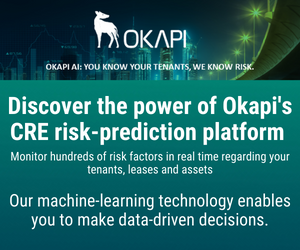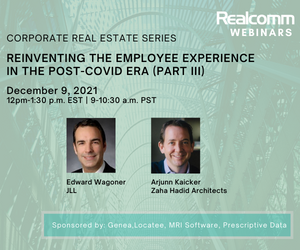Ensuring You Are Making the Best Business Decisions in a Cut-Throat World

When it comes to making decisions in your CRE business, you are relying on two factors. The first, and most important is your business acumen, your “gut instinct." This element cannot be substituted, it is based on your years of experience in the business and your innate sense of where the market is headed. The second factor is information. The real-estate business has access to vast amounts of data from many categories, so much that it is impossible to sort through manually. PropTech companies are addressing this issue to create a sharp tool for asset managers.
Back to Basics: Understanding Data
In April 2016, Forbes Magazine suggested the following line as a tweet for its readers: "“Data, information and insights are not synonyms."
This is a fascinating soundbite for the Information Age. We have access to endless quantities of data any time we want, thanks to the internet. However, making sense of this data and transforming it into something useful is another matter entirely: it takes several steps to transform raw data into actionable insights.
- An asset manager has a unit available for 1.00 per square foot. This is an example of a piece of data. Without other details, it is meaningless.
- An asset manager has warehouse space of 15,000 square feet in Phoenix, Arizona, at a cost of $1.00 per square foot per month, with a minimum lease term of 36 months. This is an example of information. We are presented with basic facts, often in a visual format, such as a chart or table.
- An asset manager signs a contract to lease warehouse space to a company for 3 years, at a cost of $1.00 per square foot per month, total $15,000 per month. The contract includes a security deposit of 2 months’ rent. The asset manager pays interest on loans for the property as well as other costs, totaling $8,700 per month, resulting in a net profit of $6,300 per month for this asset. This is an example of insight.
- An asset manager makes a net profit of $6,300 per month on a warehouse rental, which is one of several warehouses he manages in the district. The rental cost is relatively low, at just $1.00 psm/pcm compared to a local average of $1.15 psm/pcm. Having access to this information enables the landlord to choose whether to raise the price according to the local average, or to keep the price low in order to remain competitive. This is an example of actionable insight. By including context, relevance and specificity, the data analysis enables the manager to set attainable goals and make business decisions driven by the data.
From Information to Insight: Why AI is Essential
Data analysis is not a new concept. Evidence of ancient methods for recording and manipulating information dates back to ancient Greece and probably earlier. Modern data analysis can be traced back to the late 19th century with the advent of the Hollerith Tabulating Machine which enabled years-worth of census data to be processed in just three months. The development of artificial intelligence and machine learning means that vast quantities of data can now be processed and analyzed faster than ever: in 2010, an estimated 9.57 zettabytes (9.57 trillion gigabytes) of information was processed every single day, equivalent to 12 gigabytes of information per person, per day. As a result, we have deeper insights into the world around us, the ways in which a business decision on one side of the world will influence events on the other side of the world, and the ability to see the interconnectivity between different factors. The problem is, we are totally overwhelmed with data. There is plenty of information, but often very little to help us understand it.
Consultancy firm McKinsey already highlighted the crisis of a lack of data scientists several years back, and the problem continues to grow. This is where machine learning comes into its own: the very same machines which can collate the data and process it also have the ability to perform an analysis of the data in order to make it useful, in other words, the data can be turned into actionable insights.
Okapi uses augmented intelligence to transform data into risk predictions to provide actionable insights. Data is gathered from many sources, some external, and some internal. The machine-learning algorithm processes the data and performs an initial analysis, which massively reduces the amount of time and effort which would traditionally be expended on the same tasks. The algorithm flags any anomalous results which can then be checked by a human analyst, feeding the results back into the AI engine, hence the “augmented” element (the machine learns both from its own analysis and from the external analysis).
As Okapi CEO Iris Tsidon explains, “The AI engine is able to process far more data than we could ever hope to, and so it spots patterns that simply aren’t visible without the concept of 'big data'. This enables us to predict risk to a very high level of accuracy, to gain a glimpse into the future.”
This example helps to illustrate how the engine takes the raw data and presents an actionable insight: A portfolio manager in Midwest USA has a tenant renting retail space and corresponding offices. The AI engine discovers that the retailer has a parent entity. The AI then receives input from a newsfeed and discovers that the parent company is facing financial struggle in the Middle East. The engine is able to predict how high the risk will be that the tenant will default, which provides the asset manager with valuable data for making business decisions such as whether to renew a contract, or in the case of a new tenant, how high to set a security deposit.
This Week’s Sponsor
Yardi® develops and supports industry-leading investment and property management software for all types and sizes of real estate companies. Established in 1984, Yardi is based in Santa Barbara, Calif., and serves clients worldwide. For more information on how Yardi is Energized for Tomorrow, visit yardi.com.
Read Next
 5/15/2025
5/15/2025
Tech, Talent and Transformation: 2025 Digie Finalists Announced For 27 years, Realcomm has presented the Digie Awards to acknowledge companies, real estate projects, technologies, and individuals that have advanced the commercial real estate industry through the strategic use of technology, automation, and innovation.
 5/15/2025
5/15/2025
Empowering Space Management with Data-Driven Visualization For effective CRE space management, it’s critical to centralize lease data, maximize rental square footage (RSF), improve energy efficiency and reconfigure spaces to meet changing needs.
 5/8/2025
5/8/2025
The AI-Powered Workplace Evolution: Redefining the Business Landscape In today's rapidly evolving business environment, the fusion of Artificial Intelligence (AI) and Workplace Management is revolutionizing the way organizations approach workspace optimization and operational efficiency.
 3/27/2025
3/27/2025
The Convergence of Edge Computing, Cloud, and AI in Building Automation and Smart Buildings In the built environment, we have seen the convergence of Operational Technology (OT) and Information Technology (IT), later expanding to include Workplace Technologies (WP).





%20(1)%20(1)%20(1).png)








